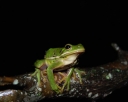Green Treefrog (Dryophytes cinerea)
Description: The frog is green, medium-sized, and up to 2.4 inches long. Their bodies are usually green in shades ranging from bright yellowish-olive to lime green. The color can change depending on lighting or temperature. Small patches of gold or white may occur on the skin, and they may also have white, pale yellow, or cream-colored lines running from their jaws or upper lips to their groins. They have smooth skin and large toe pads. Their abdomens are pale yellow to white. Males have wrinkled throats (indicating the vocal pouch) and are slightly smaller than females.
The tadpoles are green with a yellow or white stripe extending from each nostril to the eye and may have mottled tail fins.
Habitat: The frogs are considered monotypic, but clinal variation has been observed from Florida north along the Atlantic coastal plain. This may be attributed to the result of strong selection and/or drift.
Green tree frogs prefer habitats with plentiful floating vegetation, grasses, and cattails and are often found in small ponds, large lakes, marshes, and streams. They also are sometimes found at night in backyard swimming pools.
Range: These frogs are found in the central and southeastern United States, with a geographic range from the Eastern Shore of Maryland to southeast Florida, with populations as far west as central Texas, and as far north as Delaware and southern New Jersey.
Diet: American green tree frogs are insectivores, usually consuming flies, mosquitoes, and other small insects such as crickets. One study suggested the frog selects prey not by its size, but according to its activity level, with the most active prey being the most frequently eaten. The same study showed "nearly 90% of Dryophytes cinerea prey were actively pursued," with the other 10% being "insects walking or close enough to be snatched up by the frog's tongue."
Reproduction: Most American green tree frog females breed once per year, but some have multiple clutches in a single mating season. In a Florida population, "advertisement calls of males were documented between March and September and pairs in amplexus were observed between April and August." In the Florida population, the average number of offspring in a single clutch was observed to be about 400 eggs. Eggs take between four and 14 days to hatch, with an average of five days.
Breeding is known to be strongly influenced by day length, temperature, and precipitation. While "the relative influence of these factors is not well understood," it is known as the frogs generally breed the following rainfall, and males call more frequently as temperature and day length increase. Some evidence demonstrates the length of the breeding season length is correlated with latitude, with season length decreasing as latitude increases due to temperature limitations.
Males use a distinct advertisement call, "noticeably different than release or warning calls," to attract mates. Once a mate has been attracted, the pair begins amplexus, in which "the male tightly grasps onto the female to bring their cloacal openings close together for fertilization." Males are polygynous, generally seeking to mate with as many females as they can attract. Eggs are attached to substrates such as emergent vegetation, and unlike many other frog species these egg masses are typically laid in permanent bodies of water rather than seasonal vernal pools.
In southern Florida, the Cuban tree frog (Osteopilus septentrionalis) is an invasive species that has a similar call to the green tree frog in regards to timing and pitch. A study found that their calls compete acoustically with each other due to their similarity which limits communication space. In order to compete with the Cuban tree frog, green tree frogs modified their call to be shorter, louder, and more frequent so that potential mates have better chances of detecting the call. American green tree frogs show no parental investment except for mating and egg-laying.
Status: Globally classified as a Species of Least Concern. In Delaware, Illinois, & Oklahoma it is classified as Vulnerable. In Indiana it is classified as Imperiled. All other areas it is classified as either Secure or Apparently Secure.
»» Kingdom: Animalia - Animals
»» Phylum: Chordata - Chordates
»» Subphylum: Vertebrata - Vertebrates
»» Class: Amphibia - Amphibians
»» Order: Anura - Frogs & Toads
»» Family: Hylidae - Treefrogs
»» Genus: Dryophytes
»» Species: Dryophytes cinerea - Green Treefrog
»» Subspecies: None
This article uses material from the Wikipedia article "American Green Treefrog", which is released under the Creative Commons Attribution-Share-Alike License 3.0. Content may have been omitted from the original, but no content has been changed or extended.
|







